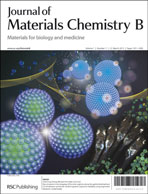Non-invasive in vivo imaging of the ionic regimes along the gastrointestinal tract of a freshwater vertebrate model organism (Japanese medaka) using responsive photonic crystal beads
Abstract
Microspherical photonic colloidal crystalline beads that are responsive to media ionic strength of cationic electrolytes have been developed for in vivo imaging of the morphology and concentration gradient of cationic electrolytes along the gastrointestinal (GI) tract of live Japanese medaka (Oryzias latipes). These responsive photonic beads were assembled from core–shell nano-sized particles with polystyrene-co-polyacrylic acid (PS-co-PAA) cores and poly(hydroxyethyl methacrylate-co-p-styrene sulfonate) (PHEMA-co-PSS) hydrogel shells. The three-dimensional orderly packing of these nano-sized core–shell particles gave rise to the photonic properties of the resultant colloidal crystalline array of microspheres. The cationic electrolyte-induced volume phase transition of the sulfonate-laden hydrogel shells of the nano-sized particles altered the lattice spacing among those particles and brought about the photonic responses of the colloidal crystalline beads. Unambiguous changes in the diffraction colour of the colloidal crystalline beads were observable under ordinary ambient light in solution media of increasing concentration of


 Please wait while we load your content...
Please wait while we load your content...